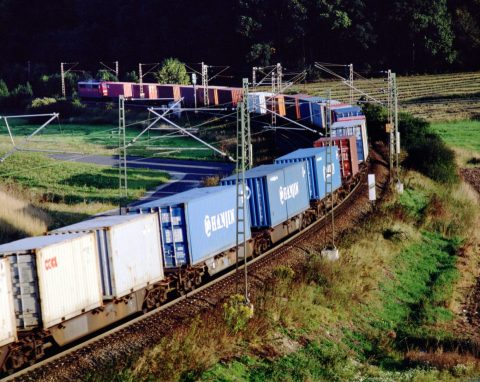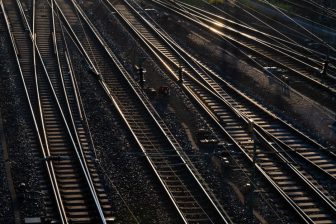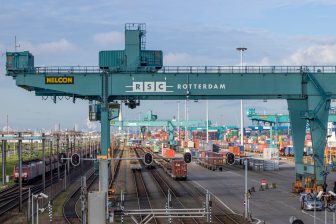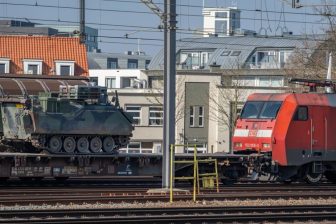
Two keys to modal shift: Collaboration & Competition
European rail freight policymakers must help ensure that national rail infrastructure managers work much more closely together to alleviate bottlenecks at borders, and thus pave the way for a much-increased sustainable modal shift from road to rail. That’s the view of Samuel Kenny, Freight and Rail Transport Officer at Transport & Environment, a Brussels-based NGO that works on EU transport policy. He outlines his views in a guest column for RailFreight.com:
Environmentalists are often heard promoting rail as a means to transport more freight and passengers. This is because rail is a lot better than road transport when it comes to greenhouse gas emissions. The European Union (EU) average amount of CO2 per tonne kilometre for a train is 18 grams (29 grams for a diesel train) while the figure is closer to 75 grams for a truck. This shows how rail transport contributes far less than road transport to climate change. Nevertheless, rail’s share of the freight market stagnates at about 18 per cent year-on-year. Compared to road, rail is far less flexible and more expensive; two majorly decisive factors for shippers who have freight to move.
So what can be done to increase freight volumes on rail?
In Europe, 50 per cent of rail freight crosses borders while only six per cent of passenger rail is international. This means that seamless travel between European countries is crucial if we are to increase the amount of goods that are transported by rail. A big factor in ensuring this is making infrastructure managers work together to communicate bottlenecks, delays and capacity. Each country in Europe has a unique infrastructure manager and these are not known for being good at speaking with one another. The EU initiative known as the ‘Rail Freight Corridors’ has improved such relationships but more needs to be done. This policy is scheduled to be reviewed later this year, which provides a big opportunity for the EU to improve such collaboration. The European Union Agency for Railways could play a bigger role in ensuring that infrastructure managers are working together more.
Priority bottlenecks
Beyond communication, smarter infrastructure investments are needed to remove bottlenecks at borders. The European Court of Auditors published its ‘Special Report – Rail freight transport in the EU: still not on the right track’ in 2016 that found how a lot of EU money being spent on rail infrastructure did not sufficiently address ‘the low speed of freight trains, administrative and technical constraints, and obsolete infrastructure’. It continues to recommend that the EU ‘target as a priority bottlenecks and missing links such as rail connections to ports and cross-border areas, as well as other measures with a potentially high impact on rail freight transport competitiveness such as the renovation of point infrastructure and last-mile facilities’.
One example of such infrastructure is the Betuweroute line, which connects Rotterdam with Germany. This freight-only infrastructure is part of the EU’s TEN-T network that aims to improve the ease at which trains can cross borders. EU investment in rail freight should be focused on reducing the waiting times at borders, improving electrical traction and enhancing technical interoperability across Europe.
Track access
Freight trains will always play second fiddle to passenger rail. When there is a problem with infrastructure that causes trains to be delayed, the passenger trains will be the first to move once the problem is solved. Furthermore, passenger trains pay far less for track access charges than freight trains. This is how it should be and is good for promoting passenger rail but bad for the cost competitiveness and speed of rail as a means to transport freight (if we compare it to road transport where there is no preferential treatment for cars over trucks in the case of traffic jams).
It’s difficult to speak about track access without highlighting the discrepancy between what rail pays and what road pays for use of infrastructure. In Germany, tolls for trucks have reduced by 15.7 per cent between 2010 and 2015 while track charges for rail have increased by 13.1%. A freight train pays about €2.60 per km while a truck pays about €0.17 per km. A decline in the price that trucks pay for tolls is not good for improving the efficiency of freight transport, nor for decarbonising the sector.
Fourth Railway
A crucial factor in improving freight volumes on rail is ensuring that infrastructure managers are independent in their decision-making. Competition has existed in the European freight market since 2007 but the benefits of such market restructuring have not been fully realised. In the recently completed Fourth Railway Package, which will open up parts of the passenger market to competition, the EU made efforts to further ensure the independence of infrastructure managers.
The European Commission had originally wanted a complete unbundling of train operator and infrastructure manager but settled for a system whereby such companies could be owned by the same entity provided that ‘Chinese walls’ were built between the two. These walls would ensure that both bodies had independent corporate governance, financing and accountability. These walls became far more permeable during the discussions with the European Parliament and member states. However, there were significant improvements made to limit the transfer of funds from one body to the other.
Decarbonising transport
The reason why infrastructure managers need to be independent is because their decisions should be based on the quality of train service and what it can bring to a country in terms of modal shift and revenue, rather than on blind allegiance to a sister company. Such protectionism limits the growth of rail and the contribution of the mode to decarbonising transport.
The EU is scheduled to review the Rail Freight Corridor Regulation later this year. This is an opportunity to further strengthen infrastructure manager communication while promoting the independence of such state-owned bodies, thus promoting the right mix of further collaboration and competition. Member states should support such a mix as this is crucial for increasing the amount of freight on rail, which has huge potential for contributing to our climate targets.
Samuel Kenny
Freight and Rail Transport Officer
Transport & Environment
Established in 1990, Transport & Environment represents 50 organisations from 26 countries across Europe. The mission is to promote, at EU and global level, a transport policy based on the principles of sustainable development. T&E have been managing a rail freight platform since 2015. This platform has provided the organisation with the opportunity to meet with key stakeholders in rail and organise workshops to discuss some of the main setbacks to modal shift.




